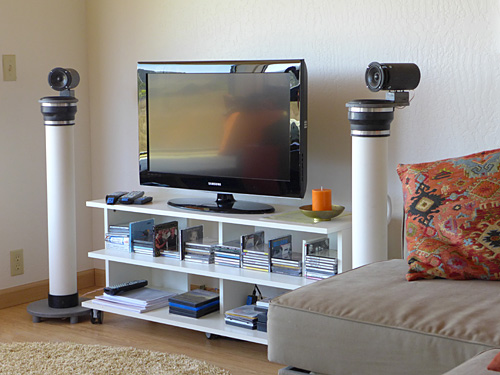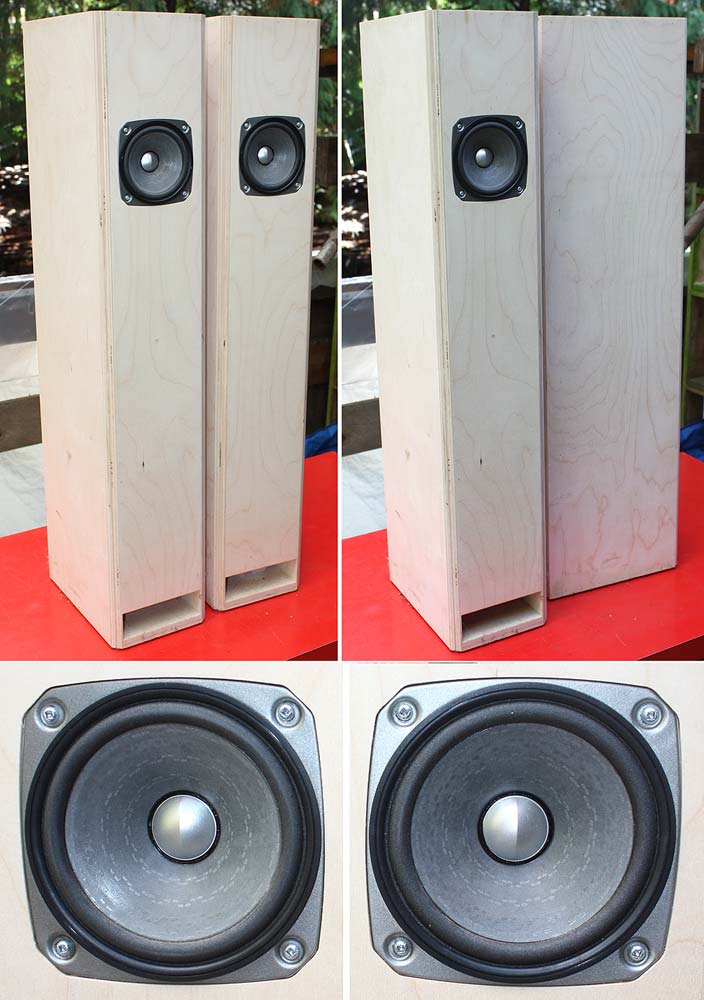So Im wanting to create a BIB speaker using Fostex FF125WK.
I have no woodworking skills apart from being able to rout circles so figured a cylinder would be easiest. No problems cutting circles into the side of a tube either, and have worked out how I can mount the driver at the appropriate level.
BIBs are traditionally narrow and deep, but if the volume is correct will a cylinder also work alright? Or does the mouth at the top have to expand for the BIB to work?
Im thinking I won't be able to achieve that very easily, but should be able to insert a piece of somewhat flexible wood into the cylinder to double the line length. It's just that it wont be expanding towards the mouth.
Anyone any experience with BIB cylinders??
Cheers
I have no woodworking skills apart from being able to rout circles so figured a cylinder would be easiest. No problems cutting circles into the side of a tube either, and have worked out how I can mount the driver at the appropriate level.
BIBs are traditionally narrow and deep, but if the volume is correct will a cylinder also work alright? Or does the mouth at the top have to expand for the BIB to work?
Im thinking I won't be able to achieve that very easily, but should be able to insert a piece of somewhat flexible wood into the cylinder to double the line length. It's just that it wont be expanding towards the mouth.
Anyone any experience with BIB cylinders??
Cheers
It would be very tricky to cut the slanted divider needed plus i’mnot sure the geometry would work. Doing an ML-TL is going to be a lot easier.
dave
dave
Woden:
GM:
dave
¾” material
Internal HxWxD = 35.5in x 5.5in x 9in.
Zd. = 7.125in.
Vent 5.5in wide x 1.875in tall.
Stuff cabinet 0.65lbs ft^3 dacron or similar & adjust to preference from there.
A removable back will make that easier.
GM:
FWIW, my take on it with a more typical 38” ear height:
L = 56”
SO/SL = 40”^2 – recommend ~ 5” x 8” golden ratio
zdriver = 18.5”
zport = 44.875”
dport = 3”
Lport = 2.5”
All dims i.d. and recommend lining top, one side and back with 1” acoustic fiberglass insulation or similar.
GM
dave
Thanks Dave, but are we talking about a box here?
Cos I can't build boxes, don't have the skills and have no intention of learning how. Think Homer Simpson's spice rack; that's my level of building ability.
But can the dimensions be used to get the volume of the box and simply translate that to a cylinder? I've built lots of stuff using plastic and cardboard cylinders and kind of know my way round those.
Cos I can't build boxes, don't have the skills and have no intention of learning how. Think Homer Simpson's spice rack; that's my level of building ability.

But can the dimensions be used to get the volume of the box and simply translate that to a cylinder? I've built lots of stuff using plastic and cardboard cylinders and kind of know my way round those.
Ok, how about a LXmini?
Built using PVC pipes, you'll need another woofer for the lows, and use the FF125wk for the higher up.

Built using PVC pipes, you'll need another woofer for the lows, and use the FF125wk for the higher up.

Thanks Dave, but are we talking about a box here?
No. Convert the width x depth to an arra and use that to tell you how big a pipe you need.
ie for Scott’s, 5.5 x 9 = 49.5 in<sup>2</sup>, Using ∏r<sup>2</sup> one gets an r of 4”, so you need an 8” ID pipe. Plug the top and bottom so that the internal height is 39.5”, mount the driver down 7 1/16” from the top and a 5.5” x 1.875” (or the circular equivalent) in the bottom piece (which ideally is ¾”). Raise it up off the floor 2 or 3” and you have the ML-TL.
dave
Thx for that suggestion but it's a fairly complex animal; DSP, four channels of power, crossover etc. I want to try to keep things relatively single-driver simple. Besides, I already have a sub sorted for lows and intend to do dual subs sometime, given my sub amp has two channels of power (bridged at present).
Ok, got it, thanks Dave.
Did you mean 35.5" for internal height?
Lots to think about, but appreciate the advice on SIS designs (Simpler is Saner).
Cheers
P
Did you mean 35.5" for internal height?
Lots to think about, but appreciate the advice on SIS designs (Simpler is Saner).
Cheers
P
Yes, 35.5” internal height.
What you are building is essentially a Pensil125, but since Pensil is reserved for Mark Audio, we call it L-Stylo125.

dave
What you are building is essentially a Pensil125, but since Pensil is reserved for Mark Audio, we call it L-Stylo125.

dave
So I went ahead anyway because of curiosity, sticking a pair of BMR 85DD F4R in PVC cylinders using the BIB worksheet and modifying length for a 7" cylinder which made them 130cm tall. The most trying part was installing the drivers in the side of a cylinder. Had to get an adjustable hole cutter for that but after lots of trial and error managed to get a good solid lock and seal.
Long story short, these rock! They sounded a bit hollow/tubey to begin with but stuffing the top end of the tube did the trick. Never had so much bass from such a small driver. The image is kind of taller and bigger than the usual boxy image. They're not that tall, about half way from floor to ceiling. But they seem to get sufficient corner reinforcement without being overblown.
On that, the aim of getting the speakers more towards the front of the room (closer to the wall where she wanted them, in other words; in the wall or outside would have been preferable!) is mission accomplished. They even look pretty good but don't ask me to post a pic; no idea how.
Next project is another set using the FF125WKs; I really like the sound of these drivers, open but not too shrill, and not too hard to drive. My 8wpc 300B amp seems happy to drive both these speakers, which are around 89dB ostensibly.
So count me another BIB convert. Really like the slimline look too. At least one of us does.
Long story short, these rock! They sounded a bit hollow/tubey to begin with but stuffing the top end of the tube did the trick. Never had so much bass from such a small driver. The image is kind of taller and bigger than the usual boxy image. They're not that tall, about half way from floor to ceiling. But they seem to get sufficient corner reinforcement without being overblown.
On that, the aim of getting the speakers more towards the front of the room (closer to the wall where she wanted them, in other words; in the wall or outside would have been preferable!) is mission accomplished. They even look pretty good but don't ask me to post a pic; no idea how.
Next project is another set using the FF125WKs; I really like the sound of these drivers, open but not too shrill, and not too hard to drive. My 8wpc 300B amp seems happy to drive both these speakers, which are around 89dB ostensibly.
So count me another BIB convert. Really like the slimline look too. At least one of us does.
nice! - how much "tilt" does the internal divider have vs perpendicular? that would be tough for me to cut.
That was a compromise decision I had to make early in the piece. No tilt at all; would have been impossible to cut it correctly. I decided to use a thin divider so I could force the issue up the top but even then I elected in the end to not bother and just cut a semicircle to block off the half pipe above the driver. It's not ideal but doesn't seem to compromise SQ. Though without a conventional rectangular pyramid for comparison and a tilted divider I guess I will never know. But it sure does pump out the bass for a 4-incher, and you can easily back it off a bit by moving away from the wall and corner boundaries.
The BMR driver has one advantage over conventional drivers in that it has a particularly wide imaging area.
The BMR driver has one advantage over conventional drivers in that it has a particularly wide imaging area.
The internal baffle runs vertically from the top to almost the bottom so around 120cm.
It is thin hardboard, a bit like MDF but slightly more flexible.
The semicircular cap you can just see in the top of the left speaker is 55cm above the centre of the driver, below which is stuffing right down to the driver. Used a bit of stuffing down the bottom too, beneath the baffle.
Hope this explains things better.
It is thin hardboard, a bit like MDF but slightly more flexible.
The semicircular cap you can just see in the top of the left speaker is 55cm above the centre of the driver, below which is stuffing right down to the driver. Used a bit of stuffing down the bottom too, beneath the baffle.
Hope this explains things better.
Cool, and I see you also have a PVC sub.
I did the same for an 8" sub over here, but there were leaks. I couldn't find a good glue that would stick to the pvc and the wood cap.
What did you use for glue?
I did the same for an 8" sub over here, but there were leaks. I couldn't find a good glue that would stick to the pvc and the wood cap.
What did you use for glue?
Gorilla Glue. Dont know if that's a worldwide tradename. Holdfast.co.nz.
Cures in three hours. Quite easy to get rid of the excess when it dries.
Most of the time I just make the circular endcap slightly bigger than the plastic enclosure and use the persuader to ensure a tight fit. Doesn't need gluing but that's easier to do with smaller enclosures. Gorilla glue for subs is quick and dirty.
The joint is hardly rock solid but it's sufficient for sealed subs; you can essentially kick the two apart later on if changes are needed or the enclosure is used for something else.
It helps using proper solid PVC mouldings which are silly expensive.
Cures in three hours. Quite easy to get rid of the excess when it dries.
Most of the time I just make the circular endcap slightly bigger than the plastic enclosure and use the persuader to ensure a tight fit. Doesn't need gluing but that's easier to do with smaller enclosures. Gorilla glue for subs is quick and dirty.
The joint is hardly rock solid but it's sufficient for sealed subs; you can essentially kick the two apart later on if changes are needed or the enclosure is used for something else.
It helps using proper solid PVC mouldings which are silly expensive.
- Status
- Not open for further replies.
- Home
- Loudspeakers
- Full Range
- BIB using PVC cylinder with FR driver
